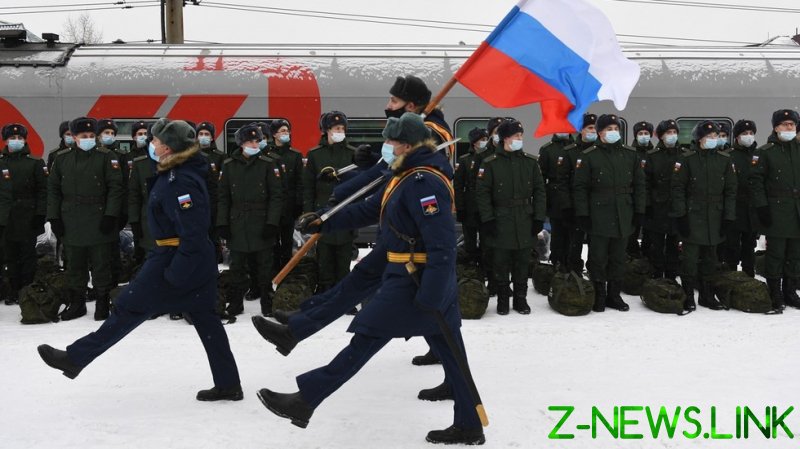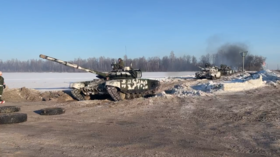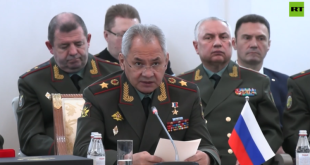
icon bookmark-bicon bookmarkicon cameraicon checkicon chevron downicon chevron lefticon chevron righticon chevron upicon closeicon v-compressicon downloadicon editicon v-expandicon fbicon fileicon filtericon flag ruicon full chevron downicon full chevron lefticon full chevron righticon full chevron upicon gpicon insicon mailicon moveicon-musicicon mutedicon nomutedicon okicon v-pauseicon v-playicon searchicon shareicon sign inicon sign upicon stepbackicon stepforicon swipe downicon tagicon tagsicon tgicon trashicon twicon vkicon yticon wticon fm
- العربية
- ESP
- РУС
- DE
- FR
Where to watch Schedule RT Shop RT News App Question more live
15 Feb, 2022 17:39 HomeRussia & FSU What does Russia’s troop pullback mean? Moscow’s announcement that some troops are withdrawing from near the border with Ukraine has sparked a media storm
As Western leaders and pundits issued fresh warnings that a Russian invasion of Ukraine could take place at any moment, and a number of countries evacuated personnel from their embassies in Kiev, Moscow’s Ministry of Defense announced on Tuesday that some of the forces it has deployed near the Ukrainian border have begun withdrawing to their bases. But is the pullback a sign that the months-long standoff could finally be winding down?
What troops? Reports that the US believed there was a Russian plan to attack Ukraine first began circulating in November last year, and despite repeated denials from Moscow that it had any aggressive intentions, fears of an invasion picked up steam over the following weeks and have hit fever pitch in recent days.
They have been fueled partly by a steady drip of releases from US President Joe Biden’s White House and State Department, as well as from the British government, with ‘declassified intelligence reports’ alleging various Russian plans for military action and regime change in Ukraine. Analysts have also pointed to reports of a buildup of more than 100,000 Russian soldiers near the two nations’ border, and the deployment of more troops to neighboring Belarus for large-scale joint military exercises, which some officials have warned could be preparation for a two-pronged assault.
Biden has said that he will not send American forces in to fight Russia in the event of war, but the US and the EU have threatened massive economic sanctions on Moscow if it attacks. As recently as this weekend, the UK claimed that it had knowledge of a Russian plan to use its FSB security agency to stage coups in major Ukrainian cities following an all-out conflict, and Jake Sullivan, national security adviser to Biden, told CNN on Sunday that “major military action” could begin “any day now.”
The Ukrainian government has received hundreds of millions of dollars in aid and military assistance from the West during this time, but the country’s economy has suffered amid anticipation of an invasion. In recent weeks, leaders from Kiev have urged people not to panic, saying that Russia is a threat, but that they do not believe an attack is likely in the near future. On Saturday, President Volodymyr Zelensky publicly requested evidence to support Western media reports that Russia was planning to attack on February 16, insisting that “everything is under control” and that diplomacy was the best solution to the current crisis.
What has Russia said? Throughout the standoff, Moscow has maintained that it never had plans to attack Ukraine and that it has a right to move its soldiers within its own territory as it sees fit. Officials have criticized the Western intelligence reports and media response as “hysteria” and “American disinformation.” However, top officials including President Vladimir Putin have voiced concerns about the large-scale security architecture of Europe, and have threatened unspecified “military-technical measures” if their demands are not met.

In December, Russia sent a list of proposals to the US and NATO, the American-led military bloc, requesting, among other demands, written guarantees that NATO would not expand into Ukraine or Georgia, two countries that border Russia. Officials from the two sides met for a series of negotiations in January, and earlier this month, Washington delivered its formal response to Moscow, rejecting limits on NATO enlargement but proposing measures for de-escalation in Europe, including increased transparency on military operations.
On Monday, Putin met with Foreign Minister Sergey Lavrov, who said that Russia was “dissatisfied” with the West’s response to its demands. However, despite warning that he is concerned about getting entangled in endless negotiations, Lavrov confirmed that he still sees the possibility for further dialogue.
And what about the withdrawal? On Tuesday, Igor Konashenkov, chief spokesperson for the Russian Ministry of Defense, released a video announcing that some of Moscow’s troops and equipment participating in joint exercises in Belarus, near the Ukrainian border, would be withdrawing to their bases in Russia, wiith the Union Courage 2022 operation coming to an end. “The divisions of the South and West Military Districts have finished their tasks and have already begun loading the rail and automobile transport, and today will begin moving back to their military garrisons,” Konashenkov explained.
The drills are scheduled to last until February 20, and Russian forces still remain near Ukraine, but the ministry’s announcement is the first sign of a major military drawdown since the initial invasion reports last year. Troops and hardware from all over the country, including those stationed in Asia, had been moved towards the frontier as part of the wargames.

The move has been lauded by representatives from Kiev and NATO, with Ukrainian Foreign Minister Dmitry Kuleba telling journalists, “We and our allies have managed to prevent Russia from any further escalation.” He added: “It is already the middle of February, and you see that diplomacy is continuing to work.” Kuleba emphasized, however, that tensions remain high and Ukraine is still waiting for Russia to pull back its remaining forces. “If a real withdrawal follows these statements, we will believe in the beginning of a real de-escalation,” he wrote on Twitter.
Jens Stoltenberg, secretary general of NATO, also commented that the organization is “cautiously optimistic” about signals from Moscow, but said he does not yet see genuine signs of de-escalation around Ukraine.
Russian officials, meanwhile, have pointed to the withdrawal announcement as proof that the West was wrong all along about the invasion. In a statement on Tuesday, Foreign Ministry spokesperson Maria Zakharova wrote, “15 February 2022 will go down in history as the day Western war propaganda failed,” adding that the West had been “shamed and destroyed without firing a single shot.”
Foreign Minister Lavrov also spoke at a press conference on Tuesday, where he said that the Russian troop pullout was simply proceeding according to schedule. “This is happening independently from whatever people are thinking, however they throw a fit about it, whoever deploys this information terrorism,” he stated. “I won’t shrink from that word. The caravan moves on.”
READ MORE: Russia reacts to West’s security proposals
The recent standoff has focused an unprecedented amount of media attention on Ukraine, with some claiming that it marks the lowest point in US-Russia relations since the end of the Cold War. The disparity between the American and the Russian versions of events has never been greater. Nonetheless, the situation resembles the moment last April when a Russian military buildup near Ukraine raised alarm in the West, only to be followed by a withdrawal, when Defense Minister Sergey Shoigu announced that snap inspections had been completed.
Then as now, the crisis is characterized by uncertainty about the extent to which Russia is threatening or posturing, and the veracity and significance of Western intelligence claims about Moscow’s plans and troop movement. In the midst of this year’s standoff, however, there have been intense, ongoing talks between Russian negotiators and those from Washington and NATO. It remains to be seen whether these conversations will lead to any permanent de-escalation, or whether the alarm bells of war will continue to sound, on and off, into the future.
© 2022, paradox. All rights reserved.





